Mars Ingenuity Pilot Touches Down at Museum
Fleischmann Auditorium vibrated with excitement like a mission control room before a downlink. The data from another planet came via Santa Barbara local Martin Cacan, Ph.D., who shared true stories from his adventures piloting a plucky little helicopter on Mars: the aptly-named Ingenuity.
Here at the Museum, we’ve been excited about Ingenuity since it first landed on the red planet with its buddy the Perseverance Rover. Both vehicles have exceeded everyone’s wildest dreams. Our Astronomy Programs staff and volunteers—many of whom are part of the local astronomy club, the Santa Barbara Astronomical Unit (SBAU)—watched with keen interest as NASA reported on Ingenuity’s unexpected endurance and continued progress. The SBAU jumped at the chance to secure Dr. Cacan as a speaker this summer.
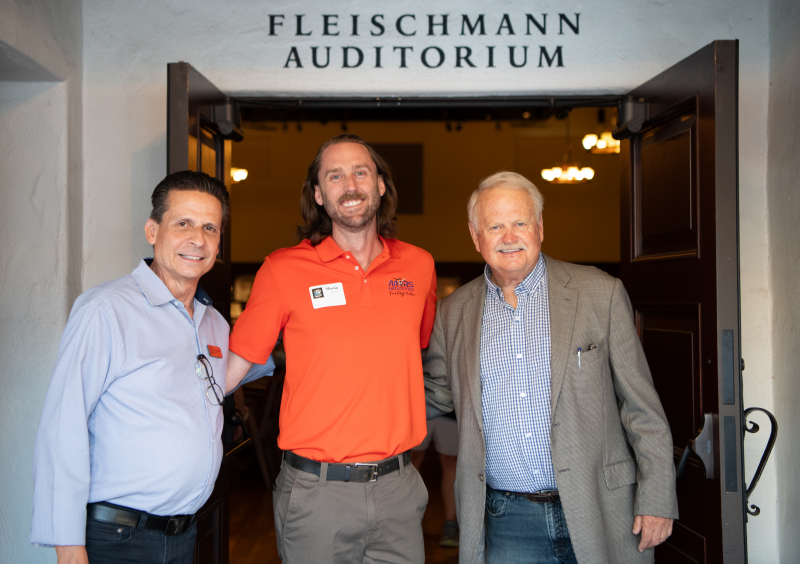
Museum President & CEO Luke Swetland (left) and Mayor of Santa Barbara Randy Rowse (right) were among the distinguished guests who came to hear Cacan (center).
Ingenuity collected views and data from Mars that no ground-bound rover or falling probe could provide. It scouted rock formations for geologists and routes for Perseverance better than a satellite could, and captured information about the winds and sand of Mars from unique vantage points in the air and on the ground. Its very existence as a functioning helicopter on such a hostile world represents an engineering achievement.
As Cacan explained in his talk, “everything is challenging on Mars,” even for mechanical equipment. “Mars is cold. One of the engineers on the project used to joke and say that Ingenuity was just a portable heater that flew sometimes.” Simply keeping Ingenuity warm enough to function took about 75% of its power, leaving only 25% to fly on.
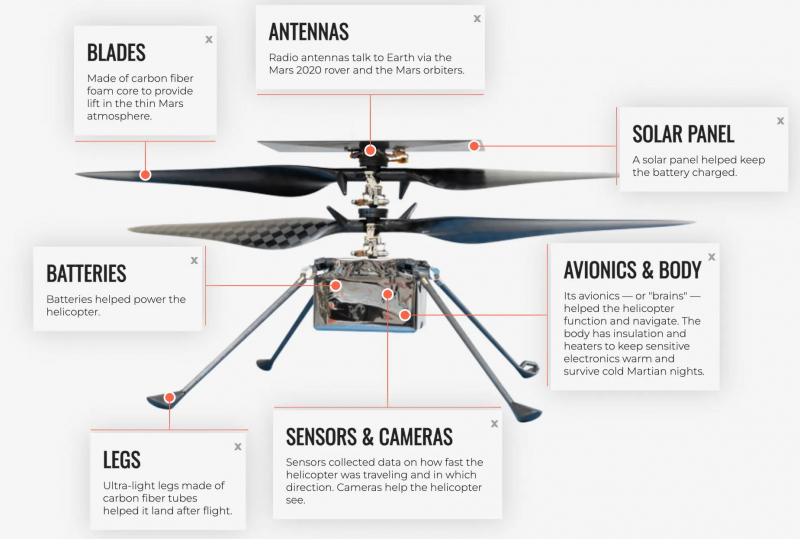
A NASA/JPL-issued diagram of the four-foot-wide Little Portable Heater That Could
The thin Martian atmosphere poses an extraordinary challenge to flight of any kind. Airplanes and helicopters create lift by manipulating the speed of the air that flows around their wings and blades. When there’s no air to speak of, that task becomes impossible. Mars has only about 1% of Earth’s atmosphere, which Cacan noted is the equivalent of the thin air found at 100,000 feet on Earth: “Imagine trying to fly a helicopter here at 100,000 feet. We don’t even fly spy planes that high.” To handle the thin air, the rotors of Ingenuity had to spin much faster than they would to lift the same craft on Earth.
To mimic the extremely low air density and composition of the Mars atmosphere, engineers at JPL performed tests of early models in a 25-foot vacuum chamber. They sucked out nearly all the air and then backfilled with nitrogen gas to replicate the Martian atmosphere. To achieve flight, they found that not only would they need to spin the rotor blades like crazy, they’d have to keep the weight of Ingenuity extremely low. The helicopter’s light weight—a mere four pounds on Earth—was achieved by Spartan restraint rather than costly custom engineering. As Cacan put it, “We are a bare-bones system here.”
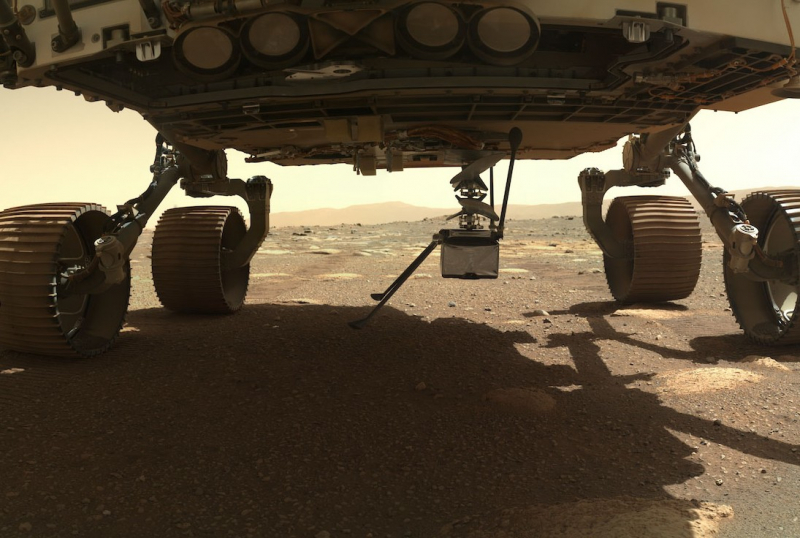
Ingenuity birthed from the belly of Perseverance. Photo by NASA/JPL-Caltech/MSSS
Cacan surprised many of us as he described how the helicopter uses “batteries like you’d probably find in the cordless drill in your garage. Most of the sensors and camera parts all came from, you know, a Pixel, an old Galaxy [phone], just a lot of commercial off-the-shelf parts.” There was at least one critically bespoke component: the solar array was “nothing like a solar panel you’d find on Earth,” since it was designed to make the best use of the specific wavelengths of sunlight received on Mars.
Juiced up, Ingenuity’s power enabled a maximum airtime of just 2.5 minutes per flight, averaging a little under a quarter mile with each trip. The team’s engineers worked hard to make the most of those minutes in the air.
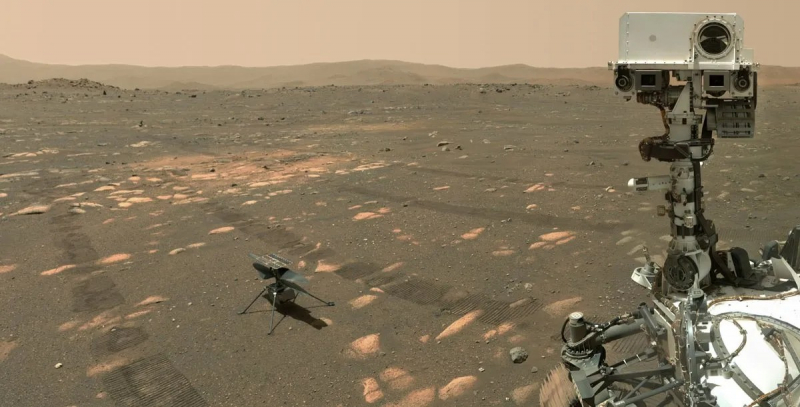
A Mars selfie captured by Perseverance (right) with Ingenuity (center). Image by NASA/JPL/MSSS
Building a helicopter capable of flight on Mars was only the first challenge—how do you pilot one? Signals can only travel so fast across the millions of miles between pilot and helicopter. It takes 6 to 18 minutes for data to be relayed from Earth to Mars and back. (The distance and time varies dramatically as Earth and Mars go on their respective orbits about the Sun.) Communications are relayed by radio signal from Earth via the Deep Space Network, to an orbiter going around Mars, to the Perseverance Rover, to the Ingenuity Helicopter. With lag like that, by the time you react to an obstacle, you’ve already crashed. So obviously “we’re not joystickin’ this thing from the ground,” Cacan noted.
Ingenuity had to be “a little bit more like your Tesla,” he explained. “We put a lot of smarts into it so that it can drive itself.” Being the pilot means “you tune the software, you pick what you need, all the parameters on a flight-by-flight basis.” Prior to each flight, they ran many simulations to check their assumptions, and after each flight, they learned. Throughout the mission, Ingenuity’s team improved its systems, adding features like the capability to self-determine the safest place to land. Finding the right landing spot could be a matter of life and death: “You can imagine that trying to land on a large rock, we’re going to tip over,” and nobody is coming from AAA to help out.
It’s critical for a self-driving craft to know where it is. There’s no GPS on Mars. The team had to use a navigation camera on Ingenuity to track the stationary features of the Martian landscape. Like a driver on Earth watching trees appear to whiz by, the helicopter tracked the apparent motion of stationary features to glean information about how it itself was actually moving.
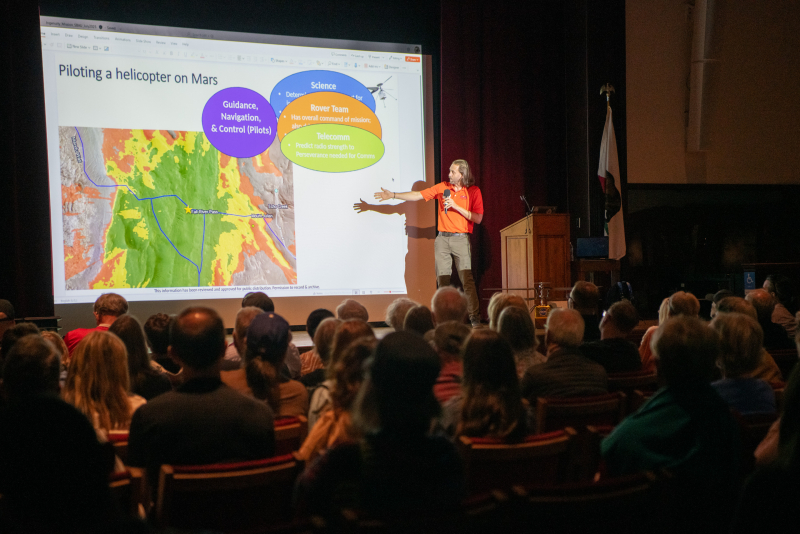
Cacan described the roles of many teams whose work was essential to Ingenuity’s success.
Since Ingenuity relied on Perseverance to relay its data, staying in close contact with the rover was another necessary condition of survival. The rover and helicopter teams worked in close collaboration to stay coordinated, and these were just two teams among many necessary for success.
“Ultimately, it’s a massive team endeavor to try and fly a helicopter on Mars,” explained Cacan. “As a pilot, I like to think to myself kind of in the hot seat, in the thick of things. But there’s a lot of people we had to coordinate with.” The various challenges of the mission required the coordination of 200 engineers—a challenge in itself.
Much of this collaborative work was conducted when many NASA staff were fully remote due to the COVID-19 pandemic. “I operated this from my kitchen and my parents’ living room,” Cacan admitted. “We literally had a legitimate JPL meeting about how to prevent cats from commanding spacecrafts.”
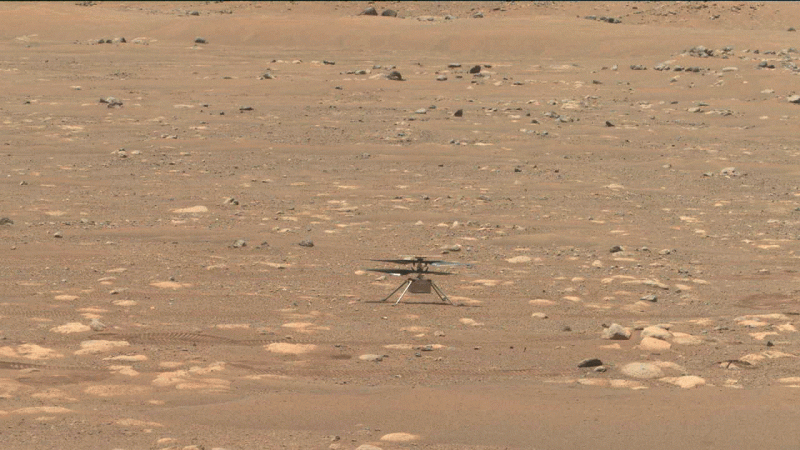
Ingenuity does a slow spin test early in its mission. Photo by NASA/JPL-Caltech/ASU
Once your helicopter on Mars can stay powered, fly without being commandeered by cats, land without tipping over, and communicate with help from its partner on the planet’s surface, what is it good for? Ingenuity was given much more time than expected to answer this question.
As a relatively inexpensive tech demo, only five flights were part of the initial plan. After those were successful, Cacan explained, “NASA was like, great, keep going!” encouraging the team to create new tools, processes, and plans to extend the helicopter’s mission in parallel with Perseverance. In the end, the wiry little helicopter flew an astonishing 72 flights, covering a total distance of about 11 miles. Cacan joined as one of Ingenuity’s pilots at flight 14, and became chief pilot at flight 38, a position he held until the end.
This NASA/JPL video celebrating Ingenuity’s fiftieth flight includes otherwordly footage from the helicopter’s and rover’s POVs.
“Having a camera on a helicopter on Mars really provided new vantages,” says Cacan. “Seeing things from the air provides a new capability, being able to traverse into areas that the rover would never go,” and depict them in greater detail and relief than a satellite could. The helicopter was a good friend to Perseverance, scouting the safety of proposed paths of travel and previewing features of the landscape to help the science team determine whether they were worth investigating with the rover. Ingenuity even provided imagery of the Perseverance Entry, Decent, and Landing hardware for engineers who designed the landing module to critique and learn from.
“The longer you spend on Mars, the more time the scientists have to come pester you and be like, hey, what if we did this?” Cacan recalled. One novel task to emerge was getting footage of the helicopter itself (taken by the rover) to reveal how dust kicked up by Ingenuity’s takeoff would move in the Martian atmosphere. “There’s a lot of uncertainty in the atmospheric models,” Cacan notes, and footage of the helicopter’s dust in action put some data into that vacuum.
“We kept pushing the boundaries of everything we could do,” including flights that went increasingly higher and farther. On a flight that soared up to 24 meters in altitude, they hovered at different stages on the way at the request of scientists who wanted to collect data about the wind at different altitude layers.
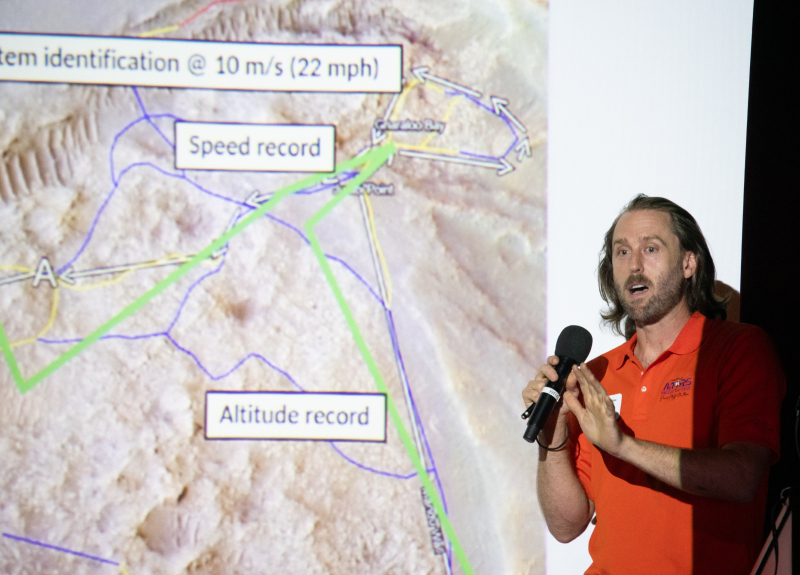
Cacan explained the challenges and record-breaking high points of the mission in fascinating detail.
Ingenuity even stayed busy during a time of unavoidable immobility. At the point in their orbits when Mars is on the opposite side of the Sun from the Earth, the Sun’s own powerful radio emissions spoil efforts to communicate by radio waves. While grounded for safety, Ingenuity parked in a sandy spot and captured a timelapse sequence of a pebbly divot, again to inform our understanding of how Martian sand moves across the surface of a planet with alien gravity and atmosphere.
This NASA/JPL-Caltech video maps Ingenuity’s 72 flights across the surface of Mars, giving an intriguing taste of the terrain navigated.
At one point, the team was able to turn Martian wind to their advantage. “Martian dust is red, but a lot of the Martian rock and regolith—kind of dirt—is black and much darker in color,” Cacan explained. “So when you see darker regions, it means something is coming through, disturbing the dust.” They used this knowledge to identify a spot where displaced sand suggested wind was coming down a channel. “We purposely parked just downstream of one of these sand ripples” and used the wind-blown sand they deduced was present to clean Ingenuity’s solar arrays. “We got 5% charging back! It was exciting.” Dust on the array slowly but significantly eroded the power efficiency of the panels during the multi-year mission, so “everyone was thrilled” by that incremental recovery.
As the mission went on, Ingenuity entered terrain that made safe landings more and more challenging. Showing us maps and photos marking this shift, Cacan recalled, “We’re no longer in a gigantic parking lot where we can go wherever we want. Now we’re traversing between large rocks and trying to find safe places to land. And it only got harder.” Over the course of the mission, they uploaded nine patches to Ingenuity’s software to help it tackle the increasing navigational challenges.
In the end, however, it was an excess of sand rather than rocks that brought Ingenuity to a stop. Cacan described the paradox: “While sand protects us from rocks, it hides some of the features we need to see.” During its final flights, Ingenuity struggled to navigate because “it could not track features in this super-bland terrain.” After flight 72, the first photo on the downlink revealed the shadow of a damaged rotor. Having exceeded expectations by 67 flights and 35 months, Ingenuity was finally grounded.
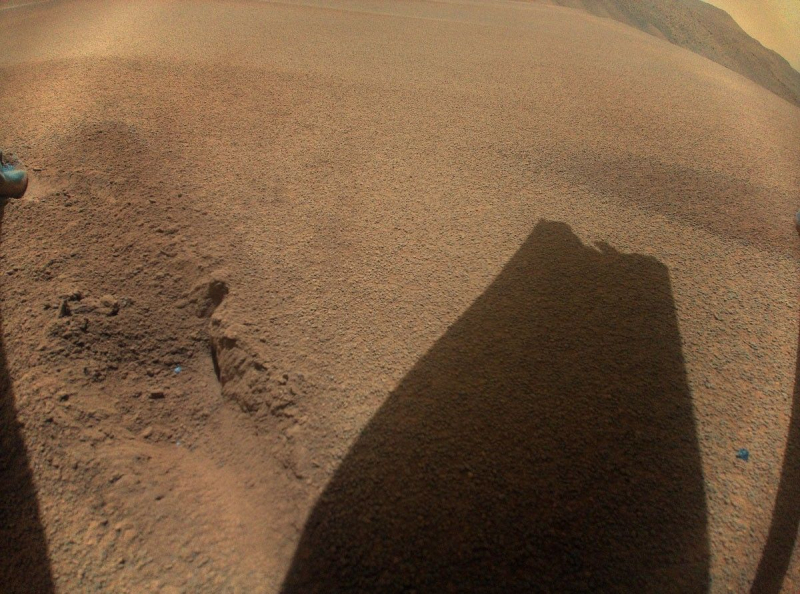
Ingenuity’s view of the shadow of its broken rotor blade. Cacan reflected: “We were designed to fly five times. And here we are on our seventy-second flight in completely undesigned-for terrain. I’m super-happy with what we accomplished.”
A couple days later, Perseverance arrived on the scene to take part in the “first aerial crash investigation on another planet. [We had] a lot of firsts,” Cacan noted proudly. “Sadly, we couldn’t confirm a cause 100%. We don’t have a black box.” The rover’s reconnaissance revealed that beyond the visibly damaged attached blade, the other rotor had been completely ejected and hurled about 20 meters away. “We believe that a hard landing caused shock through the legs to travel up into the rotor structure.”
“I’m one to say that crash is a little bit too strong of a word, but to each their own,” said Cacan. “We are grounded. . . But we are still powered, we are upright.” Ingenuity is still thought to be recording data and taking pictures on Mars daily. Because the rover has left the area, data can’t be transmitted from it. “It’s a bit of a Schrödinger’s helicopter,” he joked. “Is it alive? Is it not alive? It’s going to be a long time before we know.” Cacan hopes that when the rover returns to the spot (a rendezvous planned in five years), it can relay data back from Ingenuity once again and discover if the plucky little craft learns anything during the long solo stretch. The fact that it’s grounded in a sandy region puts it in the perfect spot to continue observing how sediment is moved by wind on Mars.
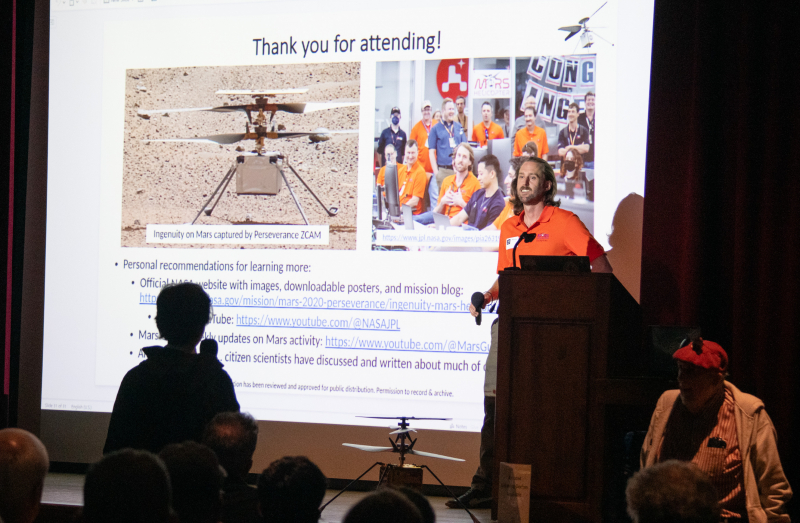
Cacan followed his 40-minute talk by fielding questions from the audience for almost as long.
Ingenuity’s success has spawned a spectrum of proposed designs for exploring Mars from the air. At the fancier end of a range of designs on the drawing board—and only proposed, not yet funded—is a larger helicopter, featuring six rotors with five or six blades each. It would weigh about 15 pounds, more than three times the weight of Ingenuity. The design of Chopper—whose name lacks the poetry of Ingenuity but is suggestive of greater power—could carry more, and travel further through more challenging terrain.
“The whole goal is to get to terrain that the geologists have always been curious about,” Cacan says. “One of the missions we’re trying to look at is to go to the equivalent of the Grand Canyon on Mars, fly up the side and look at millions or billions of years in the rock history. The geologists are super-excited for that.”
At the conclusion of his talk, Cacan fielded questions for 36 minutes on a wide range of subjects. One prompted a movie review: Being so small and light, how did Ingenuity avoid getting blown over by Martian winds? “I love The Martian as a movie and as a book,” Cacan said. “The only bad thing about it is the beginning, where they think the whole [vehicle] can get blown over by a dust storm. In 1% of Earth’s atmosphere, you could have a hundred-mile-an-hour wind blowing at you, and it would just feel like a light breeze on Earth.” That said, you don’t want to fly in a dust storm—at least one Ingenuity flight was canceled due to inclement Martian weather.
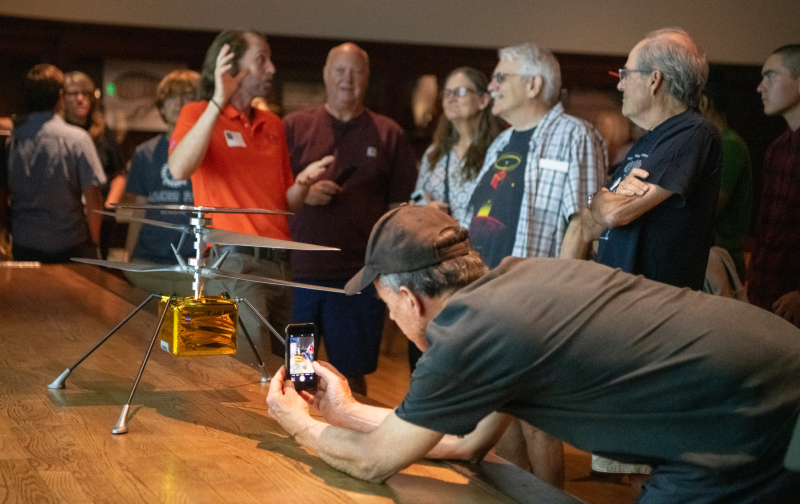
Many in attendance came up to ask further questions and snap photos of a life-size Ingenuity model.
Another suite of questions captured his thoughts on what everyone’s thinking about these days. “I think there was most likely life on Mars,” said Cacan, because of the indications that conditions were once suitable, with liquid water, organic compounds, and a warmer and more comfortable planetary history. Will humans colonize Mars? Should we? “Space is hard. Mars is a terrible place to live. . . As much as I think it would be super-fun to colonize Mars, and I think there’s value in colonizing Mars, and there’s value in colonizing the Moon, do I think it’s going to happen in our timeline? That’s kind of stretching it, in my opinion.”
From Cacan’s point of view, our current climate change scenario would have to be advanced by several centuries “before we’re starting to think that Mars might be a nice place to live.” He pointed to how little is known about medicine in low gravity environments as a major obstacle. “I think there’s a lot of questions that we don’t have answers to. . . It’s not just about getting a rocket that can get us there.”
Cacan’s visit energized us for the public debut of the Museum’s new Space Sciences exhibit just days later. If you enjoyed learning about our brush with Ingenuity, check out all our astronomy events, including more fascinating free talks organized by the SBAU!
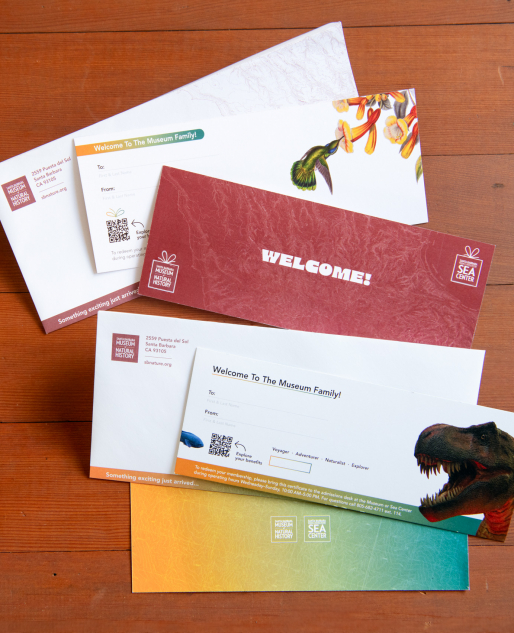
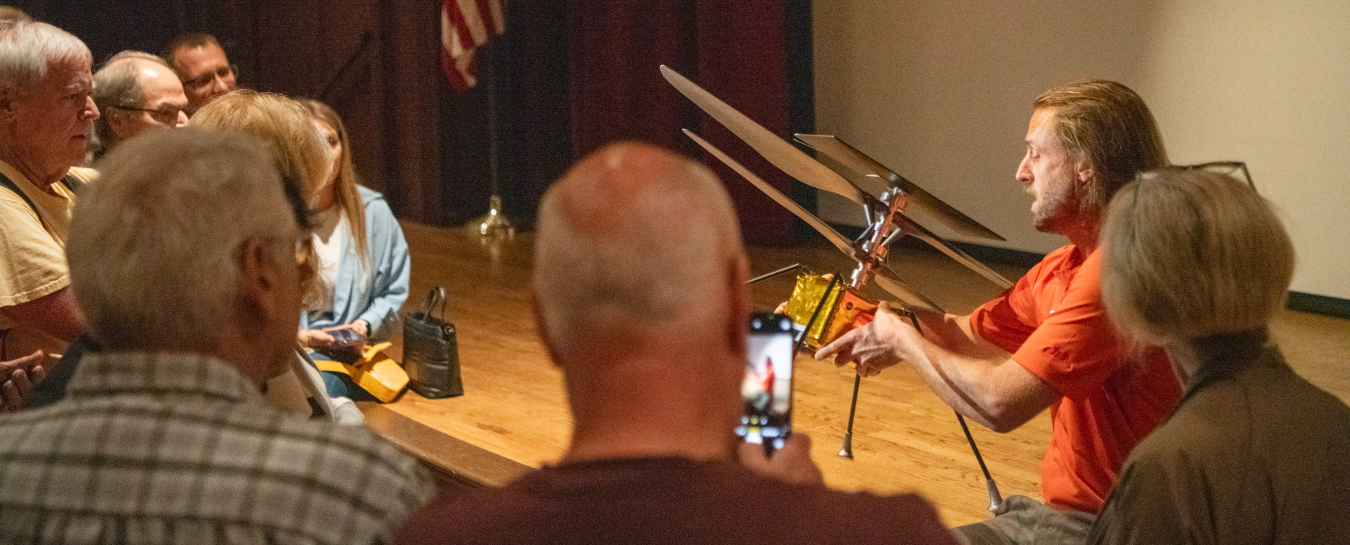
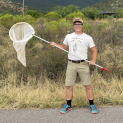




0 Comments
Post a Comment